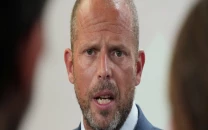Non-stop flights from Australia to London almost a reality
As long as oil prices don't go much higher than around $70 per barrel, the 20-hour flight can be financially viable

PHOTO: REUTERS
As long as oil prices don't go much higher than around $70 per barrel, the 20-hour flight can be financially viable, and could be on schedules within five years, aviation experts say.
Airbus has increased the range of its A350-900ULR to 9,700 nautical miles (17,960 kms) from the 8,700 nautical miles announced when it sold the plane to Singapore Airlines (SIAL.SI) in 2015 for delivery next year, a spokesperson told Reuters. Including headwinds, the Sydney-London flight is equivalent to 9,600 nautical miles.
World's longest flight lands in New Zealand
"These aircraft, we think, are potentially real goers on these routes," Qantas CEO Alan Joyce told Reuters of the A350-900ULR and the bigger but less advanced Boeing 777-8. "You know from what they have done on other aircraft that Sydney-London and Melbourne-London has real possibility."
For Qantas, a non-stop Sydney-London route that cuts three hours off the flight time would allow it to charge a premium and differentiate its product from the around two dozen other airlines plying the so-called Kangaroo route with stop-offs in Singapore, Dubai and Hong Kong.
The route accounts for only 13 per cent of Qantas' international capacity, but carries the prestige QF1 flight number and is important to its global brand.
Qantas could charge around a 20 per cent price premium for a non-stop Sydney-London flight as it would attract business and premium leisure travelers wanting to complete the trip as fast as possible, said Rico Merkert, a professor specialising in transport at the University of Sydney's business school.
"It's something that can be presented as a unique selling point for Qantas," he said.
Fuelling Doubts
Qantas begins non-stop flights from Perth to London next year, using the Boeing 787-9 Dreamliner. For this scheduled flight, the Dreamliner will have fewer seats than usual, will use the most advanced flight path modeling methods, and will reduce the weight in areas seemingly as minor as the dishes and forks.
The Perth flight will take 17 hours - a far cry from the four days and seven stops it took when Qantas created the Kangaroo Route to London in 1947.
Qantas can offset the higher cost of carrying more fuel to complete the flight by saving on stopover costs, such as airport charges, ground handling, taxes, crew hotel rooms and lounge usage.
"In terms of economics, much depends on fuel prices," said Teal Group aerospace analyst Richard Aboulafia. "If they stay at $50 a barrel or less, it should be possible to keep costs reasonable. But as fuel goes up, the disadvantages of flying a very heavy plane begin to make ultra-long haul problematic."
He said the flight should remain economic at prices below around $70 a barrel, though Leeham Co analyst Bjorn Fehrm said the actual level could be far higher as one-stop rivals would also be squeezed by higher oil prices.
Singapore Airlines ended its New York and Los Angeles flights using the four-engined A340-500 in 2013 when oil prices topped $107 a barrel. The carrier is now waiting for delivery of the far more fuel-efficient twin-engined A350-900ULR next year.
Headwinds
Qantas is pushing the planemakers hard on a stretch goal of completing the Sydney-London flight with 300 seats to give it the highest possible revenue and fleet flexibility.
However, Fehrm said the aircraft would likely fall short of that goal if Qantas wanted to avoid a fuel stop on the westbound leg when headwinds are strongest. If such stopovers became frequent enough, Qantas would lose its ability to charge a premium on the route.
Two aviation industry sources said the Airbus A350-900ULR would fit more than 250 passengers on the Sydney-London route, up from the 170 mainly business-class seats on Singapore Airlines' configuration for flights to New York and Los Angeles.
Boeing's 777-8, due to enter service early in the next decade, could carry around 280 passengers on the westbound leg of the Sydney-London flight, the sources said. The sources declined to be named because the configuration details are not finalised. Airbus and Boeing declined to comment specifically on the seat count.
Air India operates world's longest non-stop flight, beats Emirates
"We think our airplane has the legs and the capability," said Dinesh Keskar, Boeing Senior Vice President Sales Asia-Pacific and India. "If the 787-9 can do Perth-London, we think that when the 777-8 comes out in the 2021 timeframe we will have a lot more improvement in technology."
Airbus, Boeing and engine manufacturers are constantly investing to reduce fuel usage, extending a plane's range and its ability to perform in hot conditions like the Middle East.
That means the planemakers don't have to invest specifically for any Qantas order, the size of which is still unclear.
Pushing the seat count towards 300 would also give Qantas the flexibility to use these aircraft on other long routes, such as a mooted Sydney-New York flight, as it looks to replace six ageing 747-400ER planes and eventually its fleet of 12 A380s.



















COMMENTS
Comments are moderated and generally will be posted if they are on-topic and not abusive.
For more information, please see our Comments FAQ